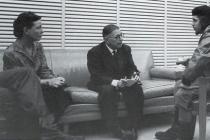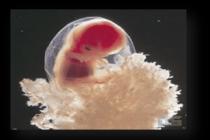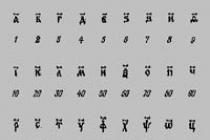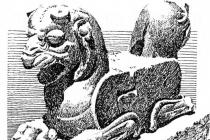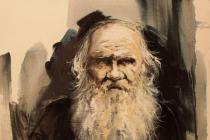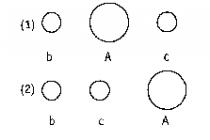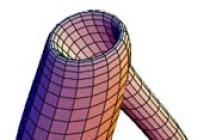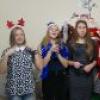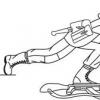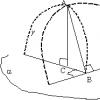History test East Slavs for students in grade 6. The test includes 2 options, each option consists of 2 parts (part A and part B). In part A - 5 questions in part B - 3 questions.
Each correct answer - 1 point.
7-8 points - excellent
5-6 points - good
3-4 points - satisfactory
less than 3 points - unsatisfactory
Option 1
A1. The invasion of what tribes in the Northern Black Sea region in the IV century. led to the destruction of the Greek and Scythian states in this region?
1) Huns
2) avar
3) Khazars
4) bulgars
A2. Which of the listed agricultural cultures was familiar to the Eastern Slavs in antiquity?
1) tomato
2) millet
3) corn
4) potatoes
A3. The skins of what fur-bearing animal did the Eastern Slavs mainly use as money, for exchange?
1) beaver
2) mink
3) foxes
4) martens
A4. Which of the following was typical for public life and economic activity of the Eastern Slavs in the 7th-8th centuries?
1) the big role of joint driven hunting
2) the massive use of slave labor on earth
3) the predominant role of craft and trade
4) joint ownership of hayfields and forest land
A5. The most developed in the cultural, political and economically the state with which the Eastern Slavs contacted in the VIII-IX centuries was
1) Sweden
2) Byzantium
3) Poland
4) Hungary
B1.
A farming system in which depleted lands in the steppe and forest-steppe regions were not plowed up for 20-30 years, until they restored fertility, and farmers moved to other plots of land.
B2. Below are the terms related to the management system and social structure of the Eastern Slavs in the 7th-8th centuries. Find and write down the serial number under which a term is indicated that does not refer to the system of government and social life of the Eastern Slavs in the 7th-8th centuries.
1) veche;
2) rope;
3) elder;
4) tribe;
5) policy.
B3. What pagan deities belonged to the pantheon of East Slavic tribes? Find two names in the list below and write down the numbers under which they appear.
1) Mokosh
2) Demeter
3) Thor
4) Veles
5) Ares
Option 2
A1. What was the name of the capital of the Khazar Kaganate?
1) Itil
2) Olbia
3) Panticapaeum
4) Bulgar
A2. What was the name of the neighboring community among the Eastern Slavs?
1) brand
2) posad
3) rope
4) polyudye
A3. What kind of management was the main one for the Eastern Slavs in the 7th-8th centuries?
1) craft
2) cattle breeding
3) agriculture
4) hunting
A4. Which of the following was characteristic of the beliefs and religious cult of the Eastern Slavs in the 7th-8th centuries?
1) the construction of large stone temples, sanctuaries to the gods
2) belief in one god
3) mass sacrifices on religious holidays
4) worship of wooden images of gods - idols
A5. Bortnichestvo is a type of economic activity associated with
1) hunting a fur animal
2) fishing
3) collecting honey
4) cattle breeding
B1. Write down the word (term) in question.
A popular assembly among the Eastern Slavs, at which the elders were chosen to conduct common affairs and the most important issues were resolved.
B2. Below are the names of East Slavic deities, spirits, evil spirits etc. Find and write down the serial number under which the name is indicated, which does not belong to the beliefs of the Eastern Slavs.
1) mermaid;
2) goblin;
3) water;
4) genie;
5) brownie.
B3. Which of the following names refer to the East Slavic tribes? Find two names in the list below and write down the numbers under which they appear.
1) Sarmatians
2) dregovichi
3) cheremis
4) Polotsk citizens
5) Bulgars
Answers to the East Slavs history test
Option 1
A1-1
A2-2
A3-4
A4-5
A5-2
B1-shifting
B2-5
B3-14
Option 2
A1-1
A2-3
A3-3
A4-4
A5-3
B1-veche
B2-4
B3-24
TEST "ORIENTAL SLAVS"
1. The East Slavic peoples include
1) Poles 2) Serbs 3) Czechs 4) Russians
2. The Slavs are
1) Chud 2) Zyryans 3) Volynians 4) Circassians
3. Non-Slavic tribe
I) Muroma 2) Polyane 3) Volynians 4) Tivertsy
4. The tribal union of Novgorod Slovenes was formed
1) in the middle reaches of the Dnieper 2) on the banks of the Ilmen Island and the Volkhov River 3) on the banks of the Oka River 4) in the upper reaches of the Volga River
5. The main branch of the economy of the Eastern Slavs in the VI VII centuries.
1) bee-keeping 2) nomadic herding 3) intermediary trade 4) slash-and-burn agriculture
6. The main deity of the pagan pantheon of the Eastern Slavs was not
1) Dazhdbog 2) Viy 3) Perun 4) Veles
7. The main city of the glades was
1) Novgorod 2) Chernigov 3) Kiev 4) Smolensk
8. The rudiments of statehood appeared earlier than others in
1) Drevlyan 2) Krivichi 3) Vyatichi 4) Polyan and Novgorod Slovens
9. The military leader of the East Slavic tribes was called
1) an elder 2) an elder 3) a prince 4) a vigilante
10. One of the initial centers of the formation of the ancient Russian state was
1) Smolensk 2) Polotsk 3) Novgorod 4) Rostov
11. The theory according to which statehood was brought to Russia by the Varangians is called
1) Slavophil 2) Norman 3) Westernizing 4) anti-Norman
12. The unification of the two centers of ancient Russian statehood took place in
1) 860 2) 862 3) 882 4) 911
13.In 862, he began to rule in Novgorod
I) Igor 2) Rurik 3) Oleg 4) Askold
14. Read the text and answer the questions
Customs and religion of the Slavs
All these tribes had their own customs, and the laws of their fathers, and traditions, and each had its own disposition. Glades have the custom of their fathers meek and quiet, shy in front of their daughters-in-law and sisters, mothers and parents; they have great modesty before mothers-in-law and in-law; they also have a marriage custom: the son-in-law does not go after the bride, but brings her the day before, and the next day they bring her for her - whatever they give. And the Drevlyans lived an animal custom, lived like a beast: they killed each other, ate everything that was not clean, and they did not have marriages, but they abducted the girls from
water. And the Radimichi, Vyatichi and the northerners had a common custom: they lived in the forest, like all animals, they ate everything that was not clean and used to shame in the presence of their fathers and daughters-in-law, and they never had marriages, but games were arranged between villages, and they converged on these games, on dances and all sorts of demonic songs, and here they snatched their wives by conspiracy with them; they had two and three wives. And if someone died, then they arranged a feast for him, and then did large deck, and put a dead man on this deck, and burned it, and after collecting the bones, put them in a small vessel and put them on pillars along the roads, as the Vyatichi still do now. The Krivichi and other pagans, who did not know the law of God, but established laws for themselves, adhered to the same custom.
The Tale of Bygone Years.
Questions:
1. Were the laws and customs of the East Slavic tribal unions the same? Why do you think?
2. When describing the customs and mores of the glades, the author of PVL cites traditions that are clearly Christian. How can you explain this?
3. What is common and what are the differences in the customs of the other listed Slavic tribal unions?
4. What features of the funeral rite of the Eastern Slavs (in particular the Vyatichi) were recorded by the author of the PVL, and which ones were omitted? Why do you think?
Ў: 15svet (C: \ Documents and Settings \ sveta.15229172177B413 \ My documents \ history \ history of ancient Russia \ tests \ TEST Eastern Slavs.doc
·
A8. Set the correspondence between the elements of the left and right columns.
A5. Rope is
A7. In case of military danger, they fought with the enemies
Similar material:
- Plan East Slavs in VI viii, 103.1kb.
- 2. Eastern Slavs. 4 versions of belonging to the Eastern Slavs, 1849.37kb.
- Topic I: Eastern Slavs. The formation of Russian statehood, 33.3kb.
- Topic East Slavs in the second half of the first millennium, 61.73kb.
- Eastern Slavs in antiquity, 321.82kb.
- Eastern Slavs and their neighbors in 6-9, 1048.19kb.
- Kievan Rus, 1956.5kb.
- Eastern Slavs now have a population speaking Russian, Ukrainian and Belarusian, 470.71kb.
- Eastern Slavs belong to the Indo-European language family (its main groups, 511.53kb.
- Factors affecting the development of the country. East Slavs. Origin, beliefs,, 511.21kb.
Option 1
A1. What was the territory of settlement of the Eastern Slavs?
1) East Asia 2) Western Europe 3) East European Plain 4) Baltic
A2. What occupation are associated with the words "podseka", "plow"; and "harrow"?
A3. What was the reason for the spread among the Eastern Slavs in the Dnieper region of the shifting system of agriculture?
1) soil fertility 2) forest cover of the region 3) use of a plow 4) marshland
A4. An excerpt from the work of the Byzantine historian: "These tribes, Slavs and Antes, are not ruled by one person, but since ancient times they have lived in the rule of the people (democracy), and therefore they consider happiness and unhappiness in life to be a common matter" - testifies that the Eastern Slavs in the VI century:
1) feudal relations were established 2) the tribal system was preserved
3) the state was formed 4) there was no division of labor between men and women
A5. The rope is:
Test 1. East Slavs
Option 2
A1. When did the Slavs settle in Eastern Europe?
1) 40 thousand years ago 2) in the VII-VI centuries. BC NS. 3) in the VI-VIII centuries. 4) in the 10th century.
A2. With what occupation are the words "pereg", "rye" and "ploughshare" connected?
1) with fishing 2) with beekeeping 3) with livestock 4) with agriculture
A3. What was the explanation for the spread of the slash-and-burn farming system among the Eastern Slavs?
1) soil fertility 2) forest cover of the region 3) lack of forest 4) use of a plow
A4. An excerpt from the composition of the Byzantine historian: “They believe that only God, the creator of lightning, is the ruler over all, and bulls are sacrificed to him and other sacred rites are performed. They worship rivers, nymphs, and all sorts of other deities, make sacrifices to all of them and with the help of these sacrifices make fortune-telling "- testifies that among the Eastern Slavs:
1) Christianity was established 2) the main occupations were fishing and navigation
3) pagan beliefs were widespread 4) there were no contacts with other countries
A5. The rope is:
1) the custom of blood feud 2) territorial (neighboring) community among the Eastern Slavs
3) a place of worship for pagan gods.
A6. The most important matters for the Slavs were decided by:
1) Family rulers 2) sorcerers 3) general council-veche
A7. In case of military danger, the enemies fought:
1) detachments of mercenary warriors from neighboring countries
2) the people's militia of the Eastern Slavs
3) well-trained detachments of professional Slavic warriors.
A8. Set the correspondence between the elements of the left and right columns.
History has preserved several names of the ancestors of the East Slavic tribes, including
Varangians, Vikings, Normans - all these are names
In which of the chronicles in the first lines the question was raised: "Where did the Russian Land come from, who began to reign in Kiev first, and where did the Russian land come from?"
The basis for which modern peoples was the ancient Russian nationality?
A5. In the pre-state period, the Eastern Slavs developed two centers in
1) Novgorod and Dnieper
2) the Volga region and the Baltics
3) Baltic and Black Sea regions
4) Volga region and Don
A6. Neighbors of the Eastern Slavs
1) Germans
2) Gauls
3) the Romans
4) Khazars
A7 ... The transition from a clan community to a neighboring one among the Eastern Slavs occurred as a result of
1) the formation of tribal alliances
2) the development of arable farming
3) the emergence of feudal estates
4) the need to defend against nomads
A8 ... A lesson in breeding bees and obtaining honey from the Slavs was called
1) beekeeping
2) architecture
3) cooper
4) pottery
A9. The main trading partner of the Old Russian state was
1) Byzantium
2) Sweden
3) Tmutarakan
4) Scythia
B1 Place in the correct sequence from north to south the rivers and lakes that were parts of the trade route "from the Varangians to the Greeks."
A) Ladoga Lake
B) Dnipro
C) Latch
D) Ilmen
B2. Establish a correspondence between the name of the tribal union of the Slavs and the place of their settlement. Enter the received answer in the table:
TRIBE | LOCATION | ||
northerners | Upper reaches of the Western Dvina, Dnieper and Volga |
||
Vyatichi | Land between Pripyat and Western Dvina |
||
Dregovichi | Lands along the Oka, Klyazma, Sestra, Moscow, Upper Volga |
||
Krivichi | Lands along Sule, Seven, Desna |
||
Lands along the Western Bug and in the spurs of the Carpathians |
Part C
1. (C4)
Name at least three provisions that characterize the occupation of the Eastern Slavs, and give at least three names of the tools of labor that they used.
2. (C4)
Name at least three provisions characterizing the beliefs of the Eastern Slavs, and give at least three names of the deities they worshiped.
3. (C4)
Name at least three provisions that characterize the social structure of the Eastern Slavs in the 6th-8th centuries, and indicate at least three basic prerequisites for the formation of a state among the Eastern Slavs.
No. 5. (C5)
Below are two points of view on the origin of the Old Russian state:
- The Old Russian state arose as a result of the formation of internal prerequisites: the development of society, social and economic shifts.
- Statehood was brought to Russia from the outside, by the Normans. Indicate which of the named points of view appears to you
more preferable and convincing. Give at least three facts, provisions that can serve as arguments confirming your chosen point of view.
No. 6. (C5)
Below are two points of view on the formation of a state among the Slavs:
- The Varangians brought statehood to the Slavic lands.
- The Varangians had little influence on the formation of the state among the Slavs.
Indicate which of the named points of view seems more preferable and convincing to you. Give at least three facts, provisions that can serve as arguments confirming your chosen point of view.
style = "position: relative;"
Test 1. East Slavs
A1. What was the territory of settlement of the Eastern Slavs?
1. East Asia
2. Western Europe
3. East European Plain
4. Baltics
A2. What occupation are associated with the words "undercut", "plow" and "harrow"?
with fishing
with beekeeping
with cattle breeding
with agriculture
A3. What was the reason for the spread of the slash-and-burn farming system among the Eastern Slavs in the Dnieper region?
1. fertility of the soil.
2.wooded edge
3.lack of forest
4. use of the plow.
A4. An excerpt from the work of the Byzantine historian: "These tribes, Slavs and Antes, are not ruled by one person, but since ancient times they have lived in the rule of the people (democracy), and therefore they consider happiness and unhappiness in life to be a common matter" - testifies that the Eastern Slavs in the 6th century:
feudal relations were established
the tribal system has been preserved
the state was formed
there was no division of labor between men and women
|
Slavic deity |
The personification of the forces of nature |
|
Perun Yarilo Stribog |
A. god of thunder and lightning B. lord of the wind V. sun god |
Key to the answers:
1A, 2B, 3B
Test 11. Final test on this topic
"Old Russian state in the 9th-first half of the 12th century."
A1. Who ruled in the Old Russian state later than others?
Svyatoslav
Igor
Oleg
Vladimir Monomakh
A2. Which prince is considered the ancestor of the dynasty of Russian princes?
Askold
Rurik
A3. What testified to the emergence of the Old Russian state among the Slavs?
1.the emergence of legislation
2.strengthening the role of elders
3. creation of the "Tale of Bygone Years"
4.the emergence of religious beliefs
A4. What was the challenge facing the Old Russian state?
1.cessation of contacts with other countries
2.provision of land allotments to all peasants-community members
3.increasing the authority of the elders
4.Ensuring the primacy of Russia on the most important trade routes
A5. What did the appearance of patrimonial land tenure in the Old Russian state testify to?
1.on the preservation of tribal relations
2.on the formation of feudal relations
3.on the transition of the Slavs to agriculture and cattle breeding
4.about the spread of Christianity
A6. The desire to strengthen state power made Prince Vladimir Svyatoslavovich:
1.to establish churchyards and lessons
2.convert to Christianity
3. to create Russian Truth
4.kill the princes of Kiev Askold and Dir
A7.
And they gathered in Lyubech to build peace. And they turned to themselves, saying: “Why are we destroying the Russian land, erecting enmity against ourselves, but the Polovtsy are tearing our land to pieces and rejoicing that there are wars between us to this day. From this time on, let us unite in one heart and protect the Russian lands. Let everyone keep their fatherland ... "and on this they kissed the cross:" if someone goes against someone (by war), then we will all ... "and, having taken an oath, went home.
1.in 862
2.in 882
3.in 988
4.in 1097
A8. Where did the words come from?
And he drove up to the glorious city of Chernigov.
Does that city of Chernigov
Black-black silushki is overtaken,
And black as black as a crow.
So no one walks around here with infantry,
Nobody rides on a good horse here,
The black crow does not fly
Let the gray beast not sprout.
1.from Russian Truth
2. from "The Tale of Bygone Years"
3. from "The Life of Boris and Gleb"
4.from the epic about Ilya Muromets
A9. What were the names of the large tribal unions of the Eastern Slavs?
1.Varangians 4.Drevlyans
2. glade 5. vyatichi
3.pechenegs
A10. Who belongs to the category of the dependent population of the Old Russian state?
1. patrimonials 4. purchases
2. slaves 5. ryadovichi
3.militaries
IN 1. Continue the logical sequence and specify the missing name.
"Teaching Children" - Vladimir Monomakh
"Word of Law and Grace" - Hilarion
"The Tale of Bygone Years" - _______________________
IN 2. Set the correspondence between the elements of the left and right columns.
|
Prince's name |
Characteristic |
|
1. Oleg 2. Igor 3. Vladimir Monomakh |
A. Inflicted a crushing defeat on the Polovtsy, adopted a new set of laws "Ustav", which eased the position of the dependent population in Russia B. He united Kiev and Novgorod under his rule, made several successful campaigns against Byzantium V. Made an unsuccessful campaign against Byzantium, killed by the Drevlyans |
AT 3. Set the correspondence between the elements of the left and right columns.
|
Term |
Definition |
|
1.beekeeping 2. churchyard 3.polyudye |
A. Collecting tribute B. Collecting honey from wild bees B. Place of collection of tribute |
The keys to the test:
2, 4, 5
2, 4, 5
IN 1. Nestor
IN 2. 1B, 2V, 3A
AT 3. 1B, 2V, 3A
Test 7. The beginning of the collapse of the Old Russian state
A1. What was the reason for the strife between the sons of Yaroslav the Wise?
1.different denominations of princes
2.the desire to obtain the title of Kiev prince
3.the will left by Prince Rurik
4.Attacks of the Polovtsians
"Teachings"
Russian Truth
"Tale of Bygone Years"
Slavic alphabet
A3. What did the decisions of the Lyubech Congress of Princes contribute to?
1.creation of the first written legislation
2.the consolidation of feudal fragmentation
3.the spread of Christianity
4.lightening the plight of slaves
A4. Associated with the name of Vladimir Monomakh:
reflection of the Polovtsian danger
foundation of Novgorod
adoption of Christianity
weakening of the power of the Kiev prince
IN 1. Arrange the following words in the spaces of the gaps. Words are given in alphabetical order in the nominative case. The answer must be a combination of the corresponding letters in the order in which the words are missing in the text. For example, GVBAD ..
A. Vladimir Monomakh
B. "The Truth of the Yaroslavichi"
V. "Russian Truth"
D. "Charter"
D. Yaroslav the Wise
The first written legislation in Russia was named (1) ________. Its compilation began in the first half of the 11th century. At this time, Kiev was ruled by (2) _______. After his death, the legislation was supplemented with new articles. These additions are named (3) _________. The legislation consolidated the inequality that arose in Russia, protected private property. In the first quarter of the XII century. the Kiev prince (4) _______ gave Russia a new set of laws. It was named (5) ___________.
Key to the answers:
IN 1. WDBAH
Test 5. The heyday of the Old Russian state
A1. For what act did Prince Svyatopolk receive the nickname The Damned?
1.for refusing to accept Christianity
2.for organizing the murder of his brothers
3.for the murder of Prince Igor
4.for organizing an unsuccessful campaign against Byzantium
A2. The era of the heyday of the Old Russian state is considered the time of reign:
Princess Olga
Prince Yaroslav the Wise
Prince Vladimir Saint
Prince Svyatoslav
A3. What did the establishment in Russian Pravda of different punishments for the same crime mean?
1.reduction of the crime rate in society
2.equalization of the entire population in rights and obligations
3.the abolition of private ownership of land and the recognition of land as a national property
4.the legislative consolidation of social inequality that has arisen in Russia
A4. What was the direction of activity of Prince Yaroslav the Wise?
setting certain norms for collecting tribute
compilation of the first written collection of laws
sending ambassadors to different countries to choose religion
fight against the Khazar Kaganate
A5. Old Russian state in the XI century. It was:
republic
empire
fragmented
feudal monarchy
|
Time |
Event |
|
IX century X century. 3.first half of the 11th century |
A. The emergence of Russian Truth B. Formation of the Old Russian state B. Baptism of Rus |
Key to the answers:
IN 1. 1B, 2V, 3A
Test 6. Inhabitants Ancient Rus
A1 What testified to the completion of the unification of all Eastern Slavs at the end of the 10th century into a single state?
1.existence of large tribal unions
2.the publication of the decree recognizing Perun as the main god
3.the emergence of a single Old Russian language
4.conclusion of dynastic marriages with the rulers of European countries
A2. What did the appearance of estates and dependent peasants in Kievan Rus mean?
development of feudal relations
establishment of a slave system
strengthening of tribal relations
strengthening the power of the church
A3. What was the main occupation of the population of Rus?
1.beekeeping
2.trade
3.craft
4. farming
A4. Who in Ancient Russia was called a slave?
totally addicted person
junior guard
free peasant commune
peasant obligated to work off a debt
A5. What word is connected in meaning with the word "epancha"?
clothes
dwelling
dishes
food
IN 1. Set the correspondence between the elements of the left and right columns.
Key to the answers:
IN 1. 1B, 2A, 3V
Option I
1 .Assign events and dates
1.1097 - a) the battle on the Kalka River;
2.1219-1222 - b) the prince of Alexander Nevsky in Vladimir;
4.153-1263 d) the conquest of Central Asia and the Caucasus by Genghis Khan;
e) Battle on the ice.
2 ... Define the following concepts:
Feudal fragmentation, ulus, baskaki, veche.
3 ... In the XII-XIII centuries. the political center of North-Eastern Russia was located in the city:
A) Moscow b) Nizhny Novgorod c) Tver d) Suzdal e) Vladimir
4. Insert the most suitable word.
On the lands of the Baltic states, a spiritual-knightly ………… .. "warriors of God" was created. Those who entered it were called swordsmen. ( Union, order, clan, squad, class)
5. When did the events described in the passage from the annals take place?
Batu came to Kiev with great strength, with many many soldiers, Batu was near the city, and his soldiers surrounded the city. And it was impossible to hear a voice from the creaking of his carts, from the roar of many of his camels, the neigh of his herds of horses, and the whole Russian land was filled with soldiers.
a) 1223 B) 1237 c) 1240 D) 1242
6 ... What event happened earlier than others?
a) the battle on Lake Peipsi b) the capture of Kiev by the Mongol-Tatars
b) the battle on the Kalka river d) the proclamation of Genghis Khan as the supreme ruler of Mongolia
7. What is the manifestation of the political dependence of Russia on the Golden Horde?
A) in the participation of Russian princes in the kurultai B) in the compulsory study of the Mongolian language
C) in the issuance of labels for reign by the Horde to Russian princes
D) in the mandatory adoption of Islam by Russian people
8. Match the elements of the left and right columns
9. The representative of the Golden Horde who supervised the collection of tribute was called _______________.
10. What is the name of the unification of two monarchical states under the rule of one monarch?
A) yoke b) union c) aggression d) dynastic marriage
11 ... The reason for the unification of the Lithuanian tribes into a single state was the desire:
A) resist the onslaught of the crusaders b) throw off the Mongol-Tatar yoke
C) convert to Catholicism c) strengthen on the trade route "from the Varangians to the Greeks"
12. Describe the reasons for the feudal fragmentation of the Old Russian state
Test on the topic "Specific Rus" grade 6
Option II
1. Correlate dates and events:
2.1236-1242 - b) the reign of Yuri Dolgoruky in the Rostov-Suzdal land;
3.125-1157 - c) the Mongol nobility assigned the title of Genghis Khan to Temuchin;
4.1206 - d) Battle of the Neva;
e) Batu's invasion.
2. Define the following concepts:
Lot, dominion, label, republic
3 Which prince among the people earned the nickname "Big Nest" for having 12 children:
A) Andrey Yuryevich b) Vsevolod Yuryevich c) Konstantin Vsevolodovich
4. When did the events described in the passage from the annals take place?
The godless Tsar Batu came to the Russian land with many Tatar soldiers .. And he sent unlucky ambassadors to Ryazan to the Grand Duke Yuri Igorevich of Ryazan, demanding from him a tenth share in everything: in princes, and in all kinds of people, and in the rest.
A) in 1223 B) in 1237 C) in 1240 D) in 1242
5. Why weren't the Mongol-Tatars able to conquer the countries of Central Europe?
A) they did not know how to overcome water obstacles
B) they had a small army
C) the Russian people put up fierce resistance to the invaders
D) the inhabitants of Central Europe were helped by the Normans
6 ... What event happened later than others?
A) the death of Genghis Khan b) the battle on Lake Peipsi
C) the capture of Ryazan by the Mongol-Tatars d) the battle on the Kalka River
7. For what purpose did Alexander Nevsky take part in the suppression of the Novgorod uprising directed against the Mongol-Tatars?
A) prevent a new Horde invasion;
B) take the post of Novgorod mayor;
C) convert to Islam;
D) enlist the support of the Horde to attack the Crusaders.
8. Set the correspondence between the elements of the left and right columns.
9 ... The system of exploitation of the Russian principalities by the Mongol conquerors was called "Mongol-Tatar ___________________"
10. What is the name of an armed attack by one or several states on another state with the aim of seizing its territory and enslaving the people?
A) union b) yoke c) aggression d) civil strife
11. What did Prince Gediminas do when he annexed the Russian lands to his possessions?
A) forced residents to accept Catholicism b) canceled the previous order of government
C) forbade the use of the Russian language d) imposed a tribute on the Russian lands
12. What is the scale and significance of the Battle of the Neva and the Battle of the Ice? What caused the special attention to them in Russian history?
Test 4. The reign of Prince Vladimir
A1. Who was the ruler of Russia in 980-1015?
1. Vladimir 2. Igor
3. Oleg 4. Svyatoslav
A2. Where did Christianity come to Russia?
from Volga Bulgaria 2.from Rome
3.from the Khazar Kaganate 4.from Byzantium
A3. The reason for the adoption of Christianity in Russia was the desire:
1.Prince Svyatoslav to intermarry with the rulers of European countries
2.Kievan princes to avoid enslavement by the Khazars
3.the inhabitants of Kievan Rus convert to Christianity
4.Kievan princes to consolidate the state and their power
A4. Conversion to Christianity:
slowed down the development of culture
led to the creation of the Old Russian state
strengthened the international position of Russia
led to the complete disappearance of paganism
A5. The activities of Prince Vladimir were aimed at:
setting certain norms for collecting tribute
conducting military campaigns against the Turkic kaganate
construction of the cities of Novgorod and Kiev
construction of defensive lines on the southern borders of the state
IN 1. Set the correct sequence of events:
A. Hike of Prince Vladimir to Chersonesos (Korsun)
B. Baptism of Rus
C. Religious reform: the proclamation of six pagan gods as the main deities of Russia
D. The beginning of the reign of Vladimir Svyatoslavovich
Option 1
A1... Who was Rus' main trading partner?
1. Byzantium 2. Sweden
3. Tmutarakan '4. Scythia
A2. With the name of which prince are the events of 882 and 907 connected?
Rurik 2. Oleg
Igor 4. Svyatoslav
A3... What contributed to the establishment by Princess Olga of lessons and churchyards?
1. development of education 2. streamlining the collection of tribute
3. strengthening ties with Byzantium 4. spread of Christianity
A4... What is the excerpt from the document about?
If the wolf gets into the habit of the sheep, it will carry away the whole flock, if they do not kill it, so will this one: if we do not kill it, then it will destroy all of us. And they sent ambassadors to him, saying: “Why are you going again? You took a tribute. "
about Oleg's campaign to Kiev 2.about Svyatoslav's campaign
3.about the uprising of the Drevlyans 4.on the attack of the Khazars
A5. What was the name of the prince's detour of the subordinate tribes and lands in the Old Russian state in order to collect tribute?
taxation 2.polyudye
3. ransom 4. offering
IN 1. Establish the sequence of reign of ancient Russian princes and princesses
D. Svyatoslav
Test 3. Formation of the Old Russian state
Option 2
A1. With the name of which prince are connected the annexation of the land of the Vyatichi and the defeat of the Khazar Kaganate?
Rurik 2. Oleg
3. Igor 4. Svyatoslav
A2... Who was the main military enemy of Russia?
Byzantium 2. Sweden
3. Tmutarakan 4. Scythia
A3. As a result of the Drevlyan uprising in 945:
The Old Russian state disintegrated
Tribute collection has been streamlined
Novgorodians invited Rurik to reign
The capital was moved from Novgorod to Kiev
A4... What is the excerpt from the document about?
And he swam to the Ugric mountain, hiding his soldiers, and sent them to Askold and Dir, telling them that "we, merchants, are going to the Greeks ... Come to us, to your relatives." When Askold and Dir came, all the rest jumped out of the boats ... killed Askold and Dir.
1. About Oleg's campaign to Kiev 2. About the invasion of the Normans
3. about the uprising of the Drevlyans 4. About the campaign of Prince Svyatoslav
A5... Places for collecting tribute, established by Olga:
1.Cities 2.People 3. Graveyards 4.Trade
IN 1... Establish the correct sequence of events.
A. Unification of Kiev and Novgorod under the rule of Oleg
B. The murder of Prince Igor by the Drevlyans
B. Establishment of lessons and churchyards by Princess Olga
D. Defeat of the Khazar Kaganate by Prince Svyatoslav
E. Calling Rurik to the Novgorod land
Test 8. Culture of Russia IX - early XII centuries.
A1. Who created the Tale of Bygone Years?
1.Historian Herodotus
2.Metropolitan Hilarion
3.Monks Cyril and Methodius
4.Monk Nestor
A2. What was the evidence of the creation of domed churches in Russia?
about the influence of Byzantium
about the predominance of pagan traditions
about the absence of building stone
about the lack of skill among ancient Russian builders
A3. Old Russian culture:
1. has come down to us only in the works of oral folk art
2.inherited the culture of the East Slavic tribes and their neighbors
3.began to develop more slowly after adopting Christianity
4. arose by the decree of Yaroslav the Wise
A4. What was the name of the openwork pattern made of thin gold or silver wire?
mosaic
fresco
filigree
granulation
A5. Which prince founded the St. Sophia Cathedral in Kiev?
Rurik
Yaroslav the Wise
Vladimir Svyatoslavovich
Vladimir Monomakh
A6. What contributed to the development of ancient Russian culture?
invasion of the Huns
the birth of cattle breeding and agriculture
emergence of inequality
adoption of Christianity
IN 1. Set the correspondence between the elements of the left and right columns. One element of the left column corresponds to one element of the right one.
|
The main genres of Old Russian literature |
Definition |
|
epic life 3.word 4.chronicle |
A. works written in the form of a solemn address B. Russian folk epic legends C. Literary Descriptions of the Lives of Christian Saints D. records of events compiled by year |
Key to the answers:
IN 1. 1B, 2V, 3A, 4G
Option 2
A1... What was the prerequisite for the formation of the state among the Eastern Slavs?
1.conclusion of a military treaty with Byzantium
2. urban development and trade
3.the emergence of religious beliefs
4.releasing from Khazar dependence
A2. Where during the formation of the Old Russian state did the Eastern Slavs have two centers of statehood?
in Novgorod and Dnieper
in the Volga region and the Baltics
in the Baltic and Black Sea regions
in the Volga region and on the Don
A3. What did the Slavs willingly buy from foreign merchants?
1.furs 2.fish
3.wax 4.silk and brocade
A4. What was the role of the Vikings in Russian history?
the Vikings founded the city of Kiev
Varangians conquered the Old Russian state
the Varangians created a state among the Eastern Slavs
the Varangians laid the foundation for the Russian princely dynasty
IN 1
A. Lake Ilmen
B. Baltic Sea
V. Lovat River
Test 2. Prerequisites for the creation of a state among the Eastern Slavs
Option 1
A1... What was the prerequisite for the formation of a state among the Eastern Slavs?
1) the onset of the glacier
2) the termination of the payment of tribute to the Varangians
3) strengthening the role of the squad and the prince
4) the division of the Slavic tribes into eastern, southern and western
A2... Where did the trade route "from the Varangians to the Greeks" lead?
from the White Sea to the Caspian
from the Baltic Sea to the Black Sea
from the White Sea to the Black Sea
from the Baltic Sea to Lake Ladoga
A3... What did foreign merchants willingly buy from the Slavs?
fur 2) gems
wine 4) silk and brocade
A4... Why were the inhabitants of the East Slavic cities forced to invite the Varangians?
the Vikings were skilled craftsmen
the Varangians protected cities and trade caravans
the Vikings founded the cities of Kiev and Novgorod
the Varangians created the Old Russian state
IN 1... Arrange the sections of the route "from the Varangians to the Greeks" in the correct sequence.
A. Dnieper river
B. Ladoga Lake
V. Volkhov River
Final test for the course “History. State and peoples of Russia: grade 6 "
A1. К During the formation of the Old Russian state in the VI-VIII centuries:
Eastern Slavs were pagans
The main occupation of the Eastern Slavs was hunting and gathering.
Eastern Slavs lived in tribal communities
Tribes of the Eastern Slavs lived along the banks of the Volga and Don rivers
A2. What was the result of the invitation to the reign of the Varangian prince?
The rule of the Rurik dynasty began in Novgorod
Christianity came to Russia
Completed the formation of the Old Russian state
The Slavs have the first written legislation
A3. Which prince is associated with the defeat of the Khazar Kaganate and the organization of military campaigns in the Balkans:
Svyatoslav
Vladimir Monomakh
Vladimir Saint
Yaroslav the Wise
A4. What was the consequence of adopting Christianity?
Weakening of the princely power
Establishment of a state among the Eastern Slavs
The emergence of feudal fragmentation
A5. What prince is involved in the excerpt from the document?
He laid ... a great city, at the same city the Golden Gate; he founded the Church of St. Sophia, the Metropolitanate, and then the Church on the Golden Gate - the Holy Mother of God of the Annunciation, then the monastery of St. George and St. Irene. And with him the Christian faith began to multiply and expand, and ... monasteries to appear.
Igor
Rurik
Yaroslav the Wise
Svyatoslav
A6. When did the congress of princes take place in Lyubech, which decreed that "everyone keeps his patrimony"?
What was the consequence of the adoption of Christianity?
in 882
in 988
in 1097
in 1147
A7. Why did the number of principalities increase in Russia in the 12th and early 13th centuries?
as a result of the development of new lands, the territory has increased
the local boyars began to claim the princely throne
a period of feudal fragmentation began
Polovtsian raids became more frequent
A8. What kind of land is being structured in an excerpt from the work of a Russian historian?
The issues to be discussed at the veche were proposed to him by the prince or by the highest dignitaries, the dignified mayor or the thousand. Veche was in charge of the entire area of legislation, all issues foreign policy and internal structure, as well as a court on political and other major crimes ... Veche decreed new laws, invited the prince or expelled him ... decided the issue of war and peace.
Kievskaya
Moscow
Novgorod
Vladimir-Suzdal
A9. In the Battle of Kulikovo, in contrast to the Battle of the Ice, the Russian army:
won
fought with the Mongol-Tatars
headed by Ivan III
fought with the troops of the Grand Duchy of Lithuania
A10. What was the name of the Horde tribute collectors in the Russian principalities?
Basque
smerds
governors
thousand
A11. What was the significance of the reign of Ivan Kalita?
he destroyed the dependence of the Russian lands on the Golden Horde
he completed the process of unification of Russian lands
he secured the Moscow principality from the raids of the Horde
he built the white-stone Moscow Kremlin
A12. What happened as a result of the unification of the Russian lands?
expansion of trade ties between regions
increase in the number of appanage principalities
development of subsistence economy
transition from appropriating to producing economy
A13. The Code of Law of Ivan III, in contrast to the Russian Pravda:
introduced blood feud for the most serious crimes
limited the right of peasants to cross over to St. George's Day
established a republican form of government
reinforced inequality
A14. The icon painters were:
Nestor and Hilarion
Afanasy Nikitin and Aristotle Fiorovanti
Andrey Rublev and Feofan the Greek
Relight and Weaken
IN 1. Set the correspondence between the elements of the left and right columns. One element of the left column corresponds to one element of the right one.
|
Definition |
|
|
Ryadovichi 2.vigilantes 3. palace peasants |
A. dependent peasants living on the lands of the grand duke B. warriors of the armed detachments of princes B. persons in the Old Russian state who served the feudal lords under a treaty |
IN 2. Set the correspondence between the elements of the left and right columns. One element of the left column corresponds to one element of the right one.
|
Concept |
Definition |
|
fiefdom 2.the estate 3.sloboda |
A. part of the city inhabited by people of similar professions B. land ownership given for military and government service, without the right to sell, exchange or inherit B. hereditary land ownership of the feudal lord |
AT 3. Continue the logical series and indicate the missing name
Alexander Yaroslavovich - the Neva river
Dmitry Ivanovich - Don River
Ivan III - river ______________
AT 4. Set the correspondence between the elements of the left and right columns. One element of the left column corresponds to one element of the right one.
|
Historical period |
event |
|
1.the formation and flourishing of the Old Russian state 2.period of feudal fragmentation 3.the formation of a centralized state |
A. calling the Vikings to Russia B. institution of the elderly B. invasion of Khan Batu |
AT 5. Arrange the following words in the spaces of the gaps. Words are given in alphabetical order in the nominative case. The answer must be a combination of the corresponding letters, built in the order in which the words are missing in the text. For example, GZVBAZHED. Please note that one of the concepts is superfluous.
A. Veche
B. Kievan Rus
V. Prince
G. Primitive communal
E. Russian centralized state
E. Feudal fragmentation
J. Feudal Republic
Z. Feudal
TO IX century in Russia (1) ______ system was formed. The wealthy people were no longer satisfied with the order of government that had developed in the tribes, since it could not ensure the protection of their property and create conditions for its increase. The first state of the Eastern Slavs was named (2) ______. The supreme power in it belonged to (3) __________.
At the beginning XII century. a new slogan was voiced and legitimized: "everyone keeps his patrimony." This marked the beginning of (4) __________. The forms of the political system in the Russian lands during this period were very diverse: from the feudal monarchy to the existing one in Novgorod and Pskov (5) ___________. The supreme power in these cities belonged to (6) ____________.
Later, the leading place among the cities of Russia was taken by Moscow. She led the struggle for the overthrow of the Golden Horde yoke and the unification of the Russian lands. As a result of the active policy of the Moscow princes in the XVI

